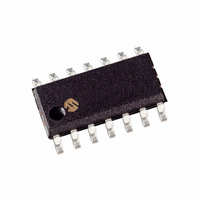HCS473T/SL Microchip Technology, HCS473T/SL Datasheet - Page 20

HCS473T/SL
Manufacturer Part Number
HCS473T/SL
Description
IC KEELOQ 3AXIS TRANSCODR 14SOIC
Manufacturer
Microchip Technology
Series
KEELOQ®r
Type
Code Hopping Encoder and Transponderr
Specifications of HCS473T/SL
Applications
Access Control Systems
Mounting Type
Surface Mount
Package / Case
14-SOIC (3.9mm Width), 14-SOL
Lead Free Status / RoHS Status
Lead free / RoHS Compliant
HCS473
FIGURE 3-8:
3.1.6
The decoder can use the CRC bits to check the data
integrity before processing begins. The CRC is calcu-
lated on the previously transmitted bits (Figure 3-2),
detecting all single bit and 66% of all double bit errors.
EQUATION 3-1:
and
with
and Di
3.1.7
The Counter Overflow Bits may be utilized to increase
the 16-bit synchronization counter range from the nom-
inal 65,535 to 131,070 or 196,605. The bits do not exist
when the device is configured for 20-bit counter opera-
tion.
The bits must be programmed during production as ‘1’s
to be utilized. OVR0 is cleared the first time the syn-
chronization counter wraps from FFFFh to 0000h.
OVR1 is cleared the second time the synchronization
counter wraps to zero. The two bits remain at ‘0’ after
all subsequent counter wraps.
DS40035C-page 18
Note:
CRC 0 [ ]
n
the nth transmission bit 0 ≤ n ≤ 64
LED -
LED - V
See Section 4.0, Programming Specs, for
information on programming OVR bits.
CYCLE REDUNDANCY CHECK
(CRC)
COUNTER OVERFLOW BITS
(OVR1, OVR0)
CRC 1 [ ]
n
+
1
V
(good battery)
(flat battery)
CRC 1 0 ,
DD
DD
=
SWITCH Sx
n
>V
≤V
+
(
CRC 0 [ ]
[
LED OPERATION
CRC CALCULATION
1
LOWSEL
LOWSEL
DATA
=
]
CRC 0 [ ]
0
=
n
⊕
0
Di
n
n
⊕
)
⊕
Di
CRC 1 [ ]
n
T
T
Code Word
LEDON
LEDON
n
Preliminary
Code Word
T
LEDOFF
3.1.8
The Discrimination Value is typically used by the
decoder in a post-decryption check. It may be any
value, but in a typical system it will be programmed
equal to the Least Significant bits of the serial number.
The discrimination bits are part of the information that
form the encrypted portion of the transmission
(Figure 3-2). After the receiver has decrypted a trans-
mission, the discrimination bits are checked against the
receiver’s stored value to verify that the decryption pro-
cess was valid; appropriate decryption key was used. If
the discrimination value was programmed as the LSb’s
of the serial number then it may merely be compared to
the respective bits of the received serial number.
The discrimination bit field size varies with the counter
select (CNTSEL) option (Figure 3-2).
3.2
The HCS473’s Transponder mode allows it to function
as a bi-directional communication transponder. Com-
mands are received on the LC pins, responses may be
returned on either the LC pins or DATA pin for short
range LF or long range RF responses, respectively.
Transponder mode capabilities include:
• A bi-directional challenge and response sequence
• Read selected EEPROM areas.
• Write selected EEPROM areas.
• Request a code hopping transmission.
• Proximity Activation of a code hopping transmis-
• Address an individual transponder when multiple
for IFF validation.
sion.
units are within the LF field; device selection for
anticollision communication purposes.
Code Word
Transponder Mode
DISCRIMINATION VALUE (DISC)
2002 Microchip Technology Inc.














